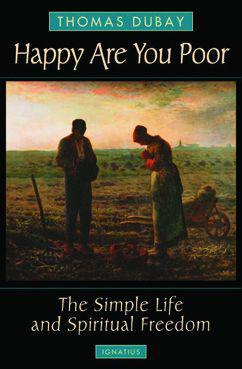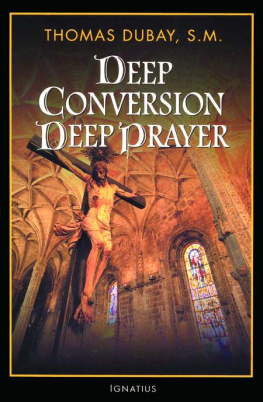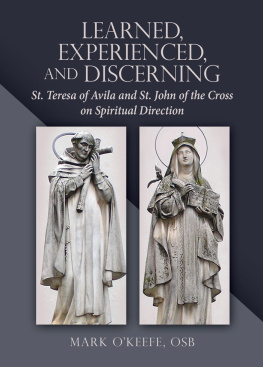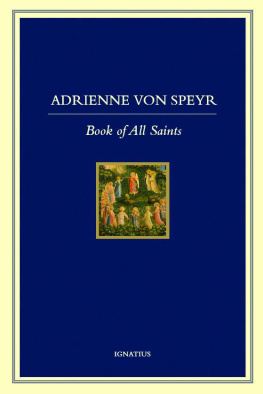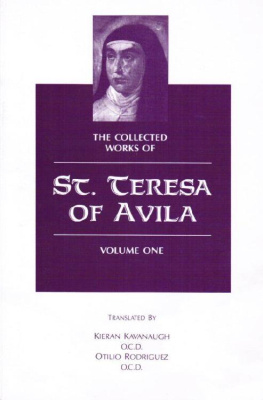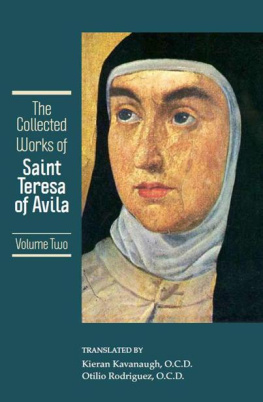FIRE WITHIN
THOMAS DUBAY, S.M.
FIRE WITHIN
St. Teresa of Avila,
St. John of the Cross,
and the Gospelon Prayer
IGNATIUS PRESS SAN FRANCISCO
Cover art by Brother Claude Lane, O.S.B.
Cover design by Roxanne Mei Lum
With, ecclesiastical approval
1989 Ignatius Press, San Francisco
All rights reserved
ISBN 978-0-89870-263-7
ISBN 0-89870-263-1
Library of Congress catalogue number 89-83633
Printed in the United States of America
CONTENTS
ACKNOWLEDGMENTS
I wish to acknowledge gratefully the use of a number of editions of the primary sources, that is, the writings of the two saints and the contemporary witnesses to their lives. For the latter I am indebted to the Carmel of Flemington, New Jersey, for excerpts taken from their private printing of the Depositions of the Processes of St. Teresa of Jesus , translated by Elvira Sarmiento and a Carmelite of Grand Rapids, Michigan, published by the Carmel of Flemington in 1969. For most of St. Teresas works, major and minor, I have used the translations of E. Allison Peers, some published by one firm, others by another. For The Way of Perfection and the Interior Castle I have cited from the Image edition of Doubleday and Company (Garden City, New York, 1964 and 1961, respectively). For her Book of Foundations and almost all of her minor works ( Constitutions, Visitation, Maxims, Answer to a Spiritual Challenge, Judgment, Thoughts and Maxims ) use has been made of volume 3 of The New Ark Library (London and New York: Sheed and Ward, 1963). References to the saints letters come from The Letters of St. Teresa of Jesus , two volumes translated and edited by E. Allison Peers (London: Sheed and Ward, 1951). Her autobiography, The Life, Spiritual Testimonies and Soliloquies are from The Collected Works of St. Teresa , volume 1, translated by Kieran Kavanaugh and Otilio Rodriguez (copyright 1976 by Washington Province of Discalced Carmelites. ICS Publications, 2131 Lincoln Road NE, Washington, D.C. 20002). All citations from St. John of the Cross are from The Collected Works of St. John of the Cross , translated by Kieran Kavanaugh and Otilio Rodriguez (copyright 1979 by Washington Province of Discalced Carmelites. ICS Publications, 2131 Lincoln Road NE, Washington, D.C. 20002).
In the case of St. Teresa I have added references to the Kavanaugh-Rodriguez edition (volumes 2 and 3) to the Peers sources given in footnotes throughout this volume for the convenience of those readers who may wish to compare translations.
A special expression of gratitude is due to Sister Joseph Marie of the Trinity, H.T. In the quiet of her hermitage she spent long hours in putting at the service of author and reader alike her previous journalistic experience as she enhanced the text with her expert editorial improvements. She likewise spent many more hours in preparing the final typescript for the publisher.
The Author
CHAPTER ONE
A QUESTION OF RELEVANCE
The Son, radiant Image of the Fathers glory, proclaimed that He had come to cast a fire upon the earth and that He longed for it to burst into blaze. It was in the form of fiery tongues that the Holy Spirit of Pentecost descended upon a timorous group of men and women. Their minds and hearts having been enkindled with a burning love and ardent zeal, those who received the Spirit sparked the astonishing transformation of an unbelieving and corrupt civilization into a community of faith and love.
In our day the divine fire has not been extinguished. The consuming conflagration has not been contained. The proven incapacity of committees and clubs, speeches and surveys, electronics and entertainment profoundly and permanently to change vast numbers of people for the better has to be conceded. As the experience of the centuries attests, true transformations in the world and in the Church continue to come about only through the interventions of men and women on firethat is, through saints. The evidence is overwhelming. It is also widely ignored, for it contains an otherworldly wisdom that this world does not welcome. For some, taking the evidence seriously presents a snag, since it implies striving for this same kind of transformation within oneself as a starting point for improving the world. Indeed, at this very moment, deep and lasting changes in the Church are being brought about by a faithful few who are burning interiorly as a consequence of the deep prayer given by the Holy Spirit, who renews the face of the earth in ways other than our own. These quiet, humble, unassuming individuals seldom write position papers, and they are not likely to appear on controversial television talk shows or to attract frontpage headlines. They are not identified with any ism, and they care nothing for a life of luxury or notoriety. They do not achieve popular acclaim by opposing ecclesial leadership and rejecting received doctrine. Rather, they are like the saints have always been. The burning ones are the unflickering light of the world, the savory salt of the earth, the lively leaven in the mass.
Thus, contemplative husbands and wives are examples of holiness to their children not unlike a Hedwig or a Thomas More. Prayerful clergy serve to inspire parishioners through soul-stirring homilies, sound guidance in the confessional and comforting concern in times of need. Teachers who are aflame ignite their students by their contagious enthusiasm as well as by the attractiveness of the truth they proclaim. Nurses close to God have a healing influence on both soul and body. In the home, in the marketplace, in the cloister, the love steadily radiating from these simple ones permeates and invigorates the world around us. It is unmistakable evidence of God living in and among us, a clear manifestation to our world that the Incarnation has taken place. Common folk instinctively grasp this, while it easily escapes the more sophisticated, who often fail to comprehend what transcends the tangible order of meetings and strategies and publicity campaigns.
Not long ago a layman engaged me in conversation after the Sunday liturgy, his face beaming with joy. Father, Ive never heard that before, he enthused. He was referring to a theme that should be commonplace in homilies. What was this happy discovery, this good news he had never heard before? For the most part, it was two remarks, one of a first-century man, the other of a sixteenth-century woman, interwoven with about fifteen minutes of commentary.
If this had been the only time I had met with this sort of reaction to this particular message, the incident probably would not have lingered in my mind. But as I regularly travel about in retreat and lecture work, it is usual for me to encounter individuals, lay and religious alike, who are yearning for the same message. Nonetheless, I hear repeatedly that this momentous message rarely receives mention and is never explained.
What is it that so many are hungering to hear? Who were the first-century man and the sixteenth-century woman? What did they say, and to whom did they say it? Was it of enduring value, or was it merely a fad, no more than a fanciful notion? What is the explanation for the enthusiasm it continues to evoke? The extensive answer to these questions constitutes the content of this book. In brief, the homily dealt with the universal call to holiness and to a deep prayer life. The man was Paul of Tarsus, and the woman was Teresa of Avila. St. Paul told his hearers, laymen and laywomen for the most part, that they should aspire to be filled with the utter fullness of God. St. Teresa, expressly writing of generous married people seriously living their Gospel obligations, forthrightly said that there is no reason why people in the world should not attain to the very highest mansions of prayer growth, to the transforming union.
Next page

